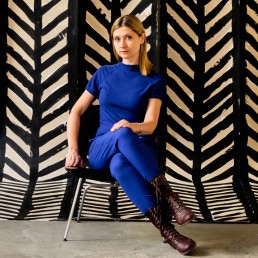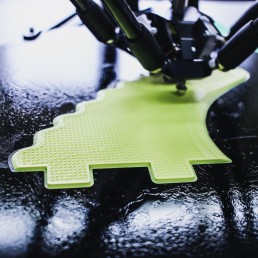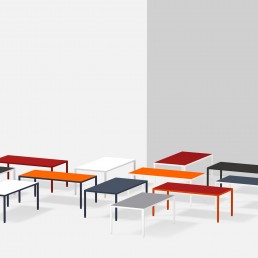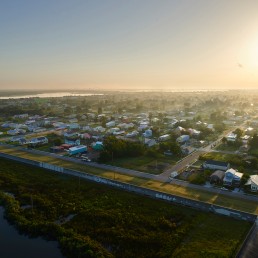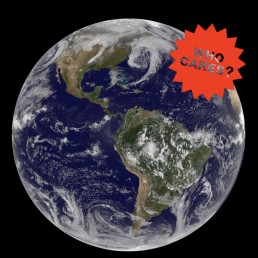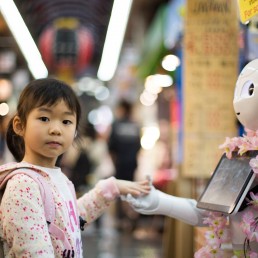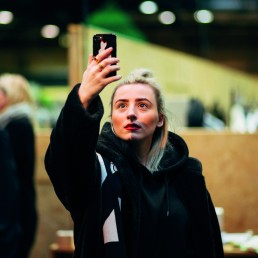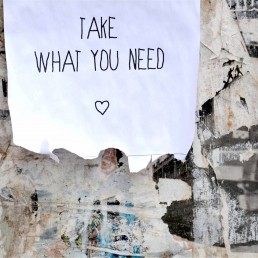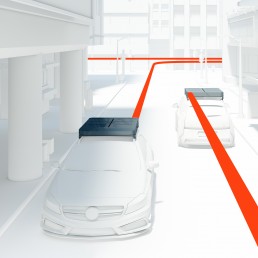![]()
Universal Communication
Does Design Create a Space for Utopias?
By Gosia Warrink, April 2018, Berlin
The video piece by the German artist Julian Rosefeldt, entitled “In the Land of Drought” (2015-2017), features an aerial perspective of individuals, clad in white full-length body suits and masks and virtually in disguise, who appear to eschew all communication with one another. In wide, desert-like landscapes, they move toward each other at very regular intervals, always in the same direction – almost resembling a swarm. Their pace is at once monotonous and resolute. A constant humming serves as the soundscape. The ground is covered in tire tracks. And the white figures, reminiscent of a legion of scientists from another age, approach deserted cities, temples and ruins, seemingly medieval at first, then ancient Egyptian, peopled only by stray dogs and the occasional bird. The disturbing impression ensues that the buildings are by no means relics of once illustrious cultures, but instead constitute sorry remnants of human civilization. In the film’s second sequence, the white figures inspect an old, derelict factory site. Precipitous towers, deep shafts – everything is rusty and lifeless. The figures continue to an amphitheater, where they congregate in a circle, subsequently proceeding to converge on the center of the stage in a pulsating rhythm before receding once more. Like a dance. Or a form of communication.
Rosefeldt’s exploration of the themes of communication and civilization exposes the nullity of human signs and of humanity’s entire existence. In Egypt, the hieroglyphs were revered as a holy, consummately accomplished writing system. Today, this system is obsolete. What will we leave behind? Will we become extinct, in the same way as the ancient Egyptians? Or perhaps emigrate to Mars? Or will beings from another planet pay the Earth a visit, who may well find our signs just as baffling as we did the hieroglyphs until the discovery of the Rosetta stone in 1799?
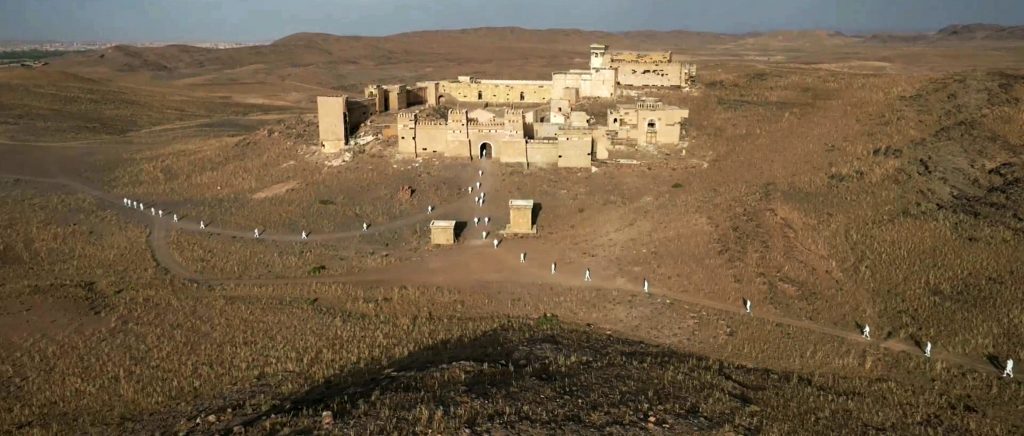
What signs and symbols will we leave behind?
The white army of scientists on an archaeological fact-finding mission reminds me of a serious, yet simultaneously curious phenomenon from the field of linguistics: Nuclear semiotics. In 1981, the US government commissioned a task force aiming to guarantee the lasting security of nuclear waste. It was charged with developing ways to reduce the likelihood of future humans unintentionally intruding on radioactive waste isolation systems, which would still be radioactive in tens of thousands of years’ time. How do you tell future generations, or people from outer space, that these zones are dangerous? In his final report, the sign theorist appointed to the task force, Thomas Sebeok, who specialized in the field of the intelligibility of signs, information boards and other non-verbal messages, ruled out all forms of verbal communication. Ideograms based on international consensus proved imprecise. Pictograms and their visual communicative power were also called into question. The task force decided that combining monumental architecture with stele inscribed in a range of languages would be the most effective solution. In a separate report, Sebeok advocated the creation of linguistic lore in the form of legends designed to remind people of these dangerous zones. No final solution has ever been forthcoming. Here, the difficulty lies in the impossibility of predicting interpretations, and the related problem of ascertaining whether a way to preserve sign systems for long periods actually exists.
Is universal language utopian?
The yearning for a collective, consummate form of communication – a common, or ideal language – emerges as early as the legend of the building of the Tower of Babel. Attempts to establish a symbolic language have been made since the 13th century, from the Majorcan scholar Ramon Llull, and the cryptography produced by the Benedictine abbot Johannes Trithemius in the 16th century to suggestions surrounding a lingua universalis, which were also investigated several times in the course of Enlightenment in the 18th century, in which Leibniz and Frege featured prominently. The 19th century was marked by linguistic movements including Volapük by Martin Schleyer and Esperanto by Ludwik Zamenhof, which strived to create a universal language. Planned languages dating from the 20th century, such as Ido, Novial and Interlingua, enjoy the status of international AUXILIARY languages. During the 1940s, Charles K. Bliss attempted to introduce his strictly logically constructed communication system BLISS with the aim of achieving cross-cultural communication, unfortunately without great success. The use of all these linguistic systems necessitates the learning of specific codes. I find a considerably more democratic approach far more interesting: A language which is intuitive and which functions on the basis of visual experience. Pictorial language is what I have in mind here. As we saw with the example of the hieroglyphs, this is the oldest language in the world and the easiest to understand, which currently finds expression in pictograms, symbols, emoticons and emojis. It is characterized by an inherent immediacy and universality which captivates, and no complicated code system forms its points of reference, but instead humanity and human artifacts.

Pictograms are used increasingly for purposes of international communication at airports and train stations. The same can be said of road signs, which were recognized as the first international icons in 1909, their status subsequently confirmed in an international agreement dated 1927. However, exceptions still exist. Japanese stop signs, for instance, differ from their European counterparts (an upside down red triangle with Japanese characters). In preparation for the cultural gathering of people from all over the world during the 2020 Olympic Games, plans are afoot to regulate traffic using, among other means, new, internationally recognized stop signs. The Olympian challenge of hosting various cultures fostered innovation back in Mexico City in 1968. Each traffic stop was marked with an individual symbol created by the American designer Lance Wyman, enabling visitors from all over the world, and the illiterate sections of the population, to navigate their way around the huge city with ease. So we see that pictorial language overcomes linguistic and cultural barriers, and yet it does limit interpretative boundaries, as touched on above as regards the problems posed by nuclear semiotics.
Depicting complex issues using images presents considerable difficulties. Not only do objects frequently possess several characteristics, but the symbolic import of the images varies significantly in cultural terms: A pig, for example, can signify food or symbolize impurity or happiness. Cultural misunderstandings lie in the eye of the beholder. The boundary to universality traces its course through the individual. And, as we saw in the case of Rosefeldt’s video piece, nothing is for all eternity. Systems of meaning fall into oblivion, even if they were, as in the case of the hieroglyphs, which began with 700 and ended with 7,000 symbols, designed for further development.
What does the future of signs demand of us as designers?
Globalization and worldwide interaction mean that the current generation of designers is required to work with universality in mind, and to display interdisciplinary skills. Written communication is increasingly taking a back seat, replaced by verbal-visual alternatives. Eighty percent of our mental capacity is occupied by visual perception. The auditive system requires a mere 10% by comparison. Today, messages are often communicated by speech recognition, and answered verbally or visually. We are familiar with the voice of Alexa, who resides in Amazon Echo. Siri, Cortana and other assistants communicate with us. Will writing even form a part of our future?
And messages are not only moving increasingly toward the visually auditive as a result of technical progress. The UNHCR ascertained that, by late 2016, over 65 million refugees were fleeing their home countries. In view of current migration patterns, the considerable need for easily comprehensible, practical and multifunctional communication systems cannot be denied. Attempts to develop universal visual codes using images – ideograms or pictograms – are in progress. And Google Translate supports auditive communication between strangers as far as technically possible. The challenge of achieving global, universal communication between all peoples has long since been taken up once more.
Moreover, economic and social globalization and migration processes create tension within the current system. I see this as an opportunity. In historical terms, innovative processes of cultural civilization took place when several cultures met (e.g. 15th century Florence or 20th century New York), Their diverse convictions, lifestyles and insights facilitated the development of new combinations ideas, promoting innovation. In one of his interviews, the psychologist Peter Kruse referred to the origins of creativity within volatile systems. Contemporary design should revive this historical window of creativity, and harness the power of the diversity unfolding before us. The time to broaden our horizons is right NOW. How can we achieve this? Let’s look at the inner stance as the basis for creativity and good design. I believe that this should be nourished by a) “thinking big”, b) diversity, c) empathy and d) network.
“Thinking big” promotes courage and opens the mind to mental experiments, hypothetical “end states” and thinking in terms of possibilities. It is, after all, generally more difficult to formulate a good question than to find a solution. It’s also difficult not to fear mistakes, instead recognizing these early on, reflecting upon them and acknowledging them as part of the creative process.
Diversity offers opportunities for cultural development via the broadening of horizons, as well as an assertive shift in terms of the understanding of design. To my mind, this is not merely something purely aesthetic, something “nice to have”, but instead constitutes substance, essence, message – also socially. I find the Anglo-American term “design” as the link between the conceptual and technical configuration of objects and systems more tangible in terms of linguistic intelligibility than the German sense, which places strong emphasis on form. Design has the potential to move people and create change. Communication design in particular not only succeeds in systematically transmitting messages filled with intrinsic meaning, but can also facilitate the communication process between two individuals in a formal sense, by attempting to do justice to the two interlocutors as individuals. Here, empathy is a key term, also serving as a central idea generator within the creative process. It acts as the basis for interdisciplinarity, sincerity, an eagerness to experiment, curiosity and optimism. Empathy presents opportunities for cultural advancement. Herein lies our chance as designers, as we, as people, work for and collaborate with other people. Empathy is neither a given, nor can it be preserved indefinitely. It requires hard work and takes effort and attentiveness. What better way to achieve this than as part of a team? Rosefeldt’s video sequence concludes with a group of dancing figures dynamically creating new formations. As they move, they form a team, heralding the beginning of a new age. It follows that real change emerges only via teamwork. So let us unite all the lateral thinkers, the experts, the networkers and all those able to contribute to an empathetic, integrative solution we can hold dear. ■

